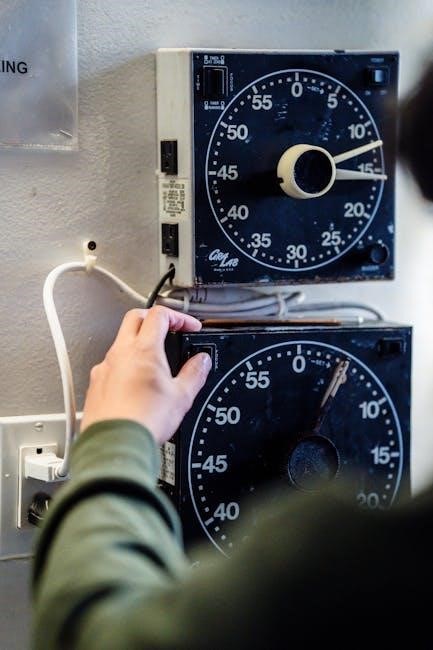Welcome to the Bryant Thermostat Owner’s Manual, your comprehensive guide to understanding and operating your new thermostat. This manual provides step-by-step instructions, feature overviews, and troubleshooting tips to ensure optimal performance and energy efficiency. Designed for ease of use, it covers installation, programming, and maintenance, helping you maximize comfort and savings. Explore innovative features and user-friendly controls to get the most out of your Bryant Thermostat.
Overview of the Bryant Thermostat

The Bryant Thermostat is a modern, energy-efficient device designed to provide precise temperature control and enhance home comfort. It offers a user-friendly interface with advanced features like smart home integration, scheduling, and remote access. Compatible with various HVAC systems, it ensures seamless operation and optimal performance. The thermostat features a sleek design, touchscreen navigation, and customizable settings to suit different lifestyles. With energy-saving modes and intuitive controls, it helps reduce energy consumption while maintaining desired comfort levels. Whether you’re looking to upgrade your current system or install a new one, the Bryant Thermostat is a reliable choice for homeowners seeking innovation and efficiency.
Importance of Reading the Manual
Reading the Bryant Thermostat Owner’s Manual is essential for understanding its features, proper installation, and optimal operation. It provides critical information on safety precautions, wiring requirements, and troubleshooting common issues. By reviewing the manual, users can unlock all thermostat functionalities, including scheduling, energy-saving modes, and smart home integration. Proper setup and configuration ensure efficient performance and prevent potential damage to the HVAC system. The manual also guides users in maintaining the thermostat and addressing errors, reducing the need for professional assistance. Familiarizing yourself with the content helps maximize energy efficiency, comfort, and system longevity. Neglecting to read the manual may lead to suboptimal performance or unintended operational issues.
Structure of the Manual
The Bryant Thermostat Owner’s Manual is organized into clear sections to ensure easy navigation and comprehension. It begins with an introduction, followed by installation and setup instructions, including compatibility checks and wiring diagrams. The manual then details the thermostat’s features, such as temperature control modes, scheduling, and smart home integration. Operating instructions cover basic controls, advanced settings, and remote access. Maintenance and troubleshooting sections provide routine care tips, error code explanations, and guidance on when professional help is needed. Additional resources include online support and warranty information. This structured approach ensures users can quickly find the information they need, from initial setup to long-term maintenance, making the manual a valuable resource for optimal thermostat performance and energy efficiency.
Installation and Setup
Welcome to the Installation and Setup section of your Bryant Thermostat Owner’s Manual. This guide provides a step-by-step walkthrough for installing your thermostat, including compatibility checks, wiring diagrams, and connections. Follow these instructions carefully to ensure a smooth and efficient setup process.

Compatibility with HVAC Systems
Ensuring your Bryant Thermostat is compatible with your HVAC system is crucial for optimal performance. The thermostat is designed to work seamlessly with a variety of heating, ventilation, and air conditioning systems, including forced air, heat pumps, and radiant systems. It is compatible with both single-stage and multi-stage HVAC systems, offering flexibility for different home configurations. Before installation, verify that your HVAC system meets the thermostat’s specifications, which can be found in this manual. Proper compatibility ensures efficient temperature control, energy savings, and reliable operation. If you’re unsure about compatibility, consult a professional to confirm your system’s requirements. This step is essential for a smooth installation and to maximize the thermostat’s features.
Step-by-Step Installation Guide
Installing your Bryant Thermostat is a straightforward process when followed carefully. Begin by turning off the power to your HVAC system at the circuit breaker. Remove the old thermostat and take note of the wiring connections for reference. Prepare the wall by ensuring it is clean and level. Mount the new thermostat base, securing it firmly with screws. Connect the wires to the appropriate terminals, matching the labels from your old thermostat. Once all wires are securely connected, restore power to the system. Turn on your HVAC system to test the thermostat’s operation. If you encounter any issues, refer to the troubleshooting section or consult a professional. Proper installation ensures reliable performance and energy efficiency.
Wiring Diagrams and Connections
Understanding the wiring diagrams and connections is crucial for a successful thermostat installation. Refer to the provided wiring diagram in your Bryant Thermostat Owner’s Manual, which illustrates the proper connections for your specific model. Typically, wires are color-coded: R (red) for 24V power, W (white) for heat, Y (yellow) for cooling, G (green) for fan, and C (common) for the return. Ensure all wires are securely connected to the correct terminals on the thermostat and your HVAC system. If your system uses a different configuration, consult the manual for guidance. Double-check all connections before restoring power to avoid malfunctions. Proper wiring ensures safe and efficient operation of your thermostat and HVAC system. Always turn off power to the system before making any wiring changes.
Post-Installation Checks
After installing your Bryant thermostat, perform a series of post-installation checks to ensure proper functionality. First, verify that the thermostat is receiving power and the display is active. Check all wiring connections to confirm they are secure and match the wiring diagram provided in the manual. Test the thermostat by adjusting the temperature settings and observing the HVAC system’s response. Ensure the thermostat is mounted level and firmly attached to the wall. Review the system’s operation in both heating and cooling modes to confirm smooth transitions. If you have smart home integration, test remote access and voice control features. Finally, review the owner’s manual for any additional checks specific to your model. Proper post-installation checks ensure reliable performance and prevent potential issues down the line.

Features and Functionalities
The Bryant thermostat offers advanced temperature control, smart home integration, energy-saving modes, and an intuitive touchscreen interface. These features enhance comfort, efficiency, and ease of use.
Overview of Thermostat Features
The Bryant thermostat is designed to provide exceptional comfort and energy efficiency. It features a user-friendly touchscreen interface, advanced temperature control modes, and smart home integration capabilities. With scheduling and programming options, you can customize your heating and cooling preferences to suit your lifestyle. Energy-saving features like geofencing and adaptive recovery ensure optimal performance while reducing energy consumption. The thermostat also offers remote access, allowing you to adjust settings from your smartphone or tablet. Additional features include humidity control, air quality monitoring, and compatibility with various HVAC systems. These functionalities work together to create a seamless and efficient home climate control experience, making the Bryant thermostat a versatile and modern solution for your home comfort needs.

Temperature Control Modes
The Bryant thermostat offers multiple temperature control modes to cater to different comfort and energy-saving needs. The Heat mode provides consistent warmth, while the Cool mode ensures refreshing air during warmer months. The Off mode disables heating and cooling, allowing you to save energy when it’s not needed. The Auto mode automatically switches between heating and cooling based on your set temperature, optimizing efficiency. Additionally, the thermostat features Emergency Heat for heat pump systems, which activates auxiliary heat in extreme cold. These modes are easily accessible through the user-friendly interface, enabling you to customize your home’s climate effortlessly. By utilizing these temperature control options, you can maintain a comfortable environment while managing energy usage effectively.
Scheduling and Programming
The Bryant thermostat allows for advanced scheduling and programming to tailor your heating and cooling preferences to your daily routine. With the ability to set temperature adjustments for different times of the day, you can optimize comfort and energy usage. The thermostat supports multiple daily schedules, enabling you to program specific temperatures for mornings, afternoons, evenings, and nights. Additionally, you can create unique schedules for weekends or special occasions. The intuitive interface makes it easy to program and adjust settings, while the thermostat’s memory retains your preferences even during power outages. By customizing your temperature schedule, you can enhance energy efficiency and ensure your home remains comfortable without unnecessary heating or cooling. This feature is particularly useful for balancing convenience and cost savings.
Smart Home Integration
The Bryant thermostat seamlessly integrates with popular smart home systems, enhancing your ability to control your home’s climate remotely. Compatible with platforms like Apple HomeKit and Amazon Alexa, this thermostat allows voice commands and app-based adjustments for effortless temperature management. Through smart home integration, you can monitor and adjust settings from anywhere, ensuring optimal comfort and energy efficiency. The thermostat also learns your preferences over time, adapting to your lifestyle for a personalized experience. Additionally, smart home integration enables features like geofencing, which adjusts temperatures based on your location, and energy usage tracking, providing insights to help you save. This advanced connectivity makes your Bryant thermostat a central part of your smart home ecosystem, offering convenience, efficiency, and peace of mind. Regular over-the-air updates ensure your system stays current with the latest features and improvements.
Energy-Saving Features
The Bryant thermostat is designed with advanced energy-saving features to help reduce your utility bills while maintaining comfort. It includes an energy usage report that tracks your consumption patterns, providing insights to optimize your settings. The thermostat also offers smart recovery, which gradually adjusts the temperature to reach your desired setting at the scheduled time, avoiding unnecessary energy use. Additionally, the energy-saving mode limits extreme temperature swings, balancing efficiency and comfort. Geofencing technology adjusts temperatures based on your location, ensuring the system isn’t heating or cooling an empty home. These features work together to create a more energy-efficient and cost-effective heating and cooling system, tailored to your lifestyle and preferences. Regular updates ensure the thermostat remains optimized for energy savings.
User Interface and Navigation
The Bryant thermostat features an intuitive user interface designed for easy navigation and control. The touchscreen display provides clear, readable menus and straightforward options, making it simple to adjust settings or access advanced features. The interface is organized into logical categories, such as temperature control, scheduling, and system settings, ensuring users can quickly find what they need. The thermostat also includes visual feedback, like color-coded indicators and progress bars, to help users understand their settings at a glance. Additionally, the interface supports swipe and tap gestures for seamless interaction. Whether you’re adjusting the temperature or programming a schedule, the user-friendly design ensures a smooth and efficient experience. This intuitive layout makes it easy for both new and experienced users to navigate and customize their thermostat settings effectively.

Operating the Thermostat
Learn how to efficiently operate your Bryant thermostat with step-by-step guidance on basic and advanced functions, ensuring optimal comfort and energy management for your home.
Basic Operations and Controls
Mastering the basic operations of your Bryant thermostat ensures seamless control over your home’s temperature. Start by familiarizing yourself with the touchscreen interface or buttons, depending on your model. Adjust the temperature by tapping the up or down arrows, or use the slide bar for precise control. Switch between heat, cool, and fan modes effortlessly. The home screen typically displays the current temperature, setpoint, and system status. Use the menu button to access quick settings like schedule overrides or energy reports. For manual operation, disable the schedule and set your preferred temperature directly. These intuitive controls make it easy to maintain comfort and efficiency without advanced setup. Regularly review the display messages to ensure your system is operating as intended.
Advanced Settings and Customization
Unlock your Bryant thermostat’s full potential by exploring advanced settings and customization options. Access the menu to adjust temperature thresholds, humidity levels, and fan operation timings. Customize geofencing settings to activate heating or cooling based on your location. Enable smart recovery to pre-cool or pre-heat your home for energy efficiency. Adjust the temperature swing range to minimize frequent cycling of your HVAC system. Explore advanced scheduling options, such as multiple daily setbacks, to tailor comfort to your lifestyle. These features allow you to fine-tune your thermostat for optimal performance and energy savings. Refer to your manual for model-specific instructions, and experiment with settings to find your ideal configuration for comfort and efficiency.
Using the Touchscreen Interface
Navigate your Bryant thermostat with ease using the intuitive touchscreen interface. Tap the screen to wake it up and access the main menu; Use swipe gestures to scroll through options like temperature adjustment, scheduling, and system settings. Adjust the screen brightness to suit your preference, ensuring visibility in any lighting condition. Access advanced features by selecting the gear icon, which opens the settings menu. Familiarize yourself with icons for heating, cooling, and fan modes. The touchscreen responds to light taps, so avoid pressing too hard. For troubleshooting, restart the thermostat by holding the power button or refer to the manual for recalibration instructions. Explore the interface to discover all customizable options and optimize your comfort experience.
Remote Access and Control
Experience the convenience of remote access and control with your Bryant thermostat. Using the Bryant Home app, available for iOS and Android, you can adjust temperature settings, monitor energy usage, and receive notifications from anywhere. Enable geofencing to automatically adjust temperatures based on your location. Voice control integration with smart home systems like Amazon Alexa and Google Assistant allows hands-free adjustments. Ensure your thermostat is connected to Wi-Fi for seamless remote operation. Schedule updates or changes to your settings remotely, saving time and energy. Access detailed usage reports to optimize your heating and cooling habits. With remote access, you can ensure your home is comfortable upon arrival and reduce energy waste when away. Secure your settings with a PIN lock to prevent unauthorized changes. Stay in control of your home’s climate, no matter where you are.
Best Practices for Efficient Operation
For optimal performance and energy savings, follow these best practices when operating your Bryant thermostat. Maintain consistent temperature settings, adjusting them only when necessary. Lower the temperature in winter and raise it in summer to reduce energy use. Utilize the programmable scheduling feature to align temperature adjustments with your daily routine. Regularly check and replace air filters to ensure proper airflow and system efficiency. Avoid placing heat-producing appliances near the thermostat to prevent inaccurate temperature readings. Enable smart features like geofencing and energy reports to monitor and optimize your usage. Consider setting a moderate temperature range to balance comfort and energy savings. By following these practices, you can enhance your home’s comfort while reducing energy consumption and extending the lifespan of your HVAC system.

Maintenance and Troubleshooting

This section provides essential maintenance tips and troubleshooting guidance for your Bryant thermostat. Learn to identify issues, interpret error codes, and know when professional assistance is needed.
Routine Maintenance Tips
Regular maintenance ensures your Bryant thermostat operates efficiently and effectively. Clean the touchscreen regularly with a soft cloth to prevent dust buildup. Check and replace batteries annually if your model requires them. Inspect wiring connections to avoid loose links, which can cause malfunctions. Update your thermostat’s software periodically to access new features and improvements. Ensure the date and time settings are correct, as incorrect settings can disrupt scheduling. Additionally, inspect the HVAC system connections to maintain proper communication. Finally, schedule professional maintenance for your HVAC system annually to ensure compatibility and optimal performance. These routine checks will help extend the lifespan of your thermostat and maintain energy efficiency.
Troubleshooting Common Issues
Troubleshooting your Bryant thermostat can resolve many common issues quickly. If the display is blank, check the power supply and circuit breaker. Ensure the thermostat is properly connected to your HVAC system. For temperature inaccuracies, recalibrate the thermostat or reset it by removing batteries for 30 seconds. If error codes appear, refer to the manual or online resources for specific solutions. Connectivity issues with smart features may require restarting the thermostat or checking Wi-Fi settings. For persistent problems, perform a factory reset by pressing and holding the menu button for 10 seconds. If issues persist, contact a certified technician. Regularly updating software and ensuring proper installation can prevent many common problems. Always consult the manual or Bryant’s official support for detailed troubleshooting guides.
Understanding Error Codes
Understanding error codes on your Bryant thermostat is crucial for effective troubleshooting. Error codes like “E1” or “E2” indicate specific issues, such as temperature sensor malfunctions or communication failures. Refer to the manual or Bryant’s online database for code meanings. Common codes include “E0” for system initialization issues or “E3” for overheating. If an error appears, restart the thermostat or check wiring connections; For persistent codes, consult the troubleshooting section or contact a professional. Keeping track of error codes helps diagnose problems quickly, ensuring your system runs efficiently. Always refer to official Bryant resources for accurate interpretations and solutions to maintain optimal performance and avoid unnecessary repairs.
When to Call a Professional
While many issues can be resolved through troubleshooting, certain situations require professional assistance. If you encounter complex wiring problems, persistent error codes, or system malfunctions despite following manual instructions, it’s time to call a professional. Issues like refrigerant leaks, compressor failures, or thermostat-hardware damage should only be handled by certified technicians. Additionally, if your thermostat is not communicating with your HVAC system or smart home devices, professional diagnosis is recommended. Don’t risk further damage or safety hazards by attempting advanced repairs yourself. A licensed technician will ensure your system operates safely and efficiently, saving you time and potential costs in the long run. Always prioritize professional help for critical or unfamiliar issues to maintain your Bryant thermostat’s performance and warranty validity.
Additional Resources
For further assistance, visit Bryant’s official website for online support, FAQs, and detailed warranty information. The Internet Archive also offers archived manuals and resources for reference.
Online Support and FAQs

Bryant’s official website offers extensive online support, including a dedicated FAQs section to address common questions about your thermostat. Find troubleshooting guides, error code explanations, and installation tips. The FAQs cover topics like temperature control, scheduling, and smart home integration, ensuring you can resolve issues quickly. Additionally, the website provides downloadable resources, such as user manuals and wiring diagrams, for easy access. For further assistance, the Internet Archive hosts archived versions of Bryant thermostat manuals, offering a reliable backup source. These online resources are designed to enhance your understanding and operation of the Bryant Thermostat, ensuring optimal performance and energy efficiency. Visit the official Bryant website or explore the Internet Archive for comprehensive support.
Warranty Information
Your Bryant Thermostat is backed by a comprehensive warranty program, ensuring protection for your investment. The limited warranty covers parts and labor for a specified period, providing peace of mind. Registration is recommended to activate warranty benefits and ensure seamless service. The warranty period varies by product and region, so refer to your manual or Bryant’s official website for details. The Internet Archive also hosts archived versions of Bryant manuals, including warranty sections, for easy access. Understanding the terms and conditions of your warranty helps you maintain coverage and resolve any potential issues promptly. For more information, visit the Bryant website or consult the warranty section in your manual.

